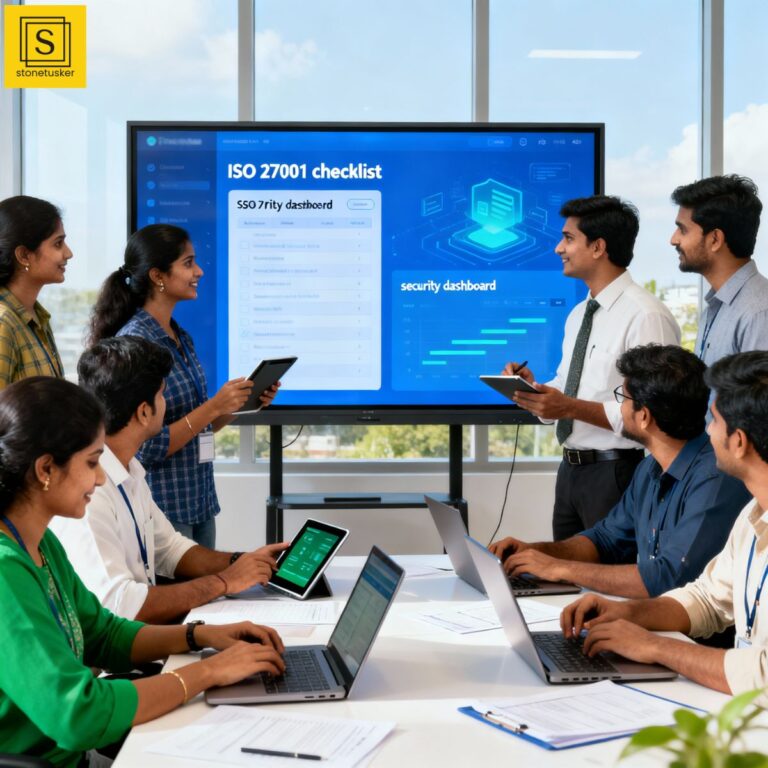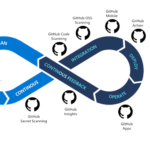Imagine your business suddenly compromised by a data breach. Sensitive client info, internal memos, strategic plans: all exposed. In today’s hyper-connected digital world, organizations can’t afford to take information security lightly. ISO 27001 certification is your shield, setting a global gold standard for robust security management.
Whether you lead a tech firm, financial institution, or an ambitious startup in India, understanding and achieving ISO 27001 sparks trust, accelerates business growth, and future-proofs your reputation. This definitive guide walks you through every step, with vivid examples, strategies, and a massive hands-on checklist to kickstart or streamline compliance.
What is ISO 27001 – Explained Simply
ISO 27001 is an internationally recognized standard (published by the International Organization for Standardization) for creating, operating, and continually improving an Information Security Management System (ISMS).
The heart of ISO 27001 lies in risk management. It systematically identifies, evaluates, and addresses risks facing organizational data, ensuring confidentiality, integrity, and availability. If a vendor or client asks for your “ISO 27001 certification,” they’re seeking proof that your business puts security first, guided by global best practices.
Why is ISO 27001 Important?
- Demonstrates to clients and stakeholders your unwavering commitment to security.
- Helps win contracts-many large enterprises and government bodies require partners to be certified.
- Mitigates risks, minimizing damage from cyber threats and compliance headaches.
- Facilitates regulatory compliance (GDPR, HIPAA, PDP Bill, RBI guidelines).
- Strengthens business reputation and operational resilience.
Technical and Business Benefits of ISO 27001
- Reduces Data Breach Costs: Organizations save money on potential penalties and lost business by preventing incidents [Dataguard].
- Increases Customer Trust: Clients prefer vendors who can prove top-notch security management.
- Improves Internal Controls: Streamlines policies and roles, optimizing resource usage and accountability.
- Boosts Competitive Advantage: Opens new markets, wins tenders, and enhances marketability.
- Reduces Human Error: Through rigorous staff training and streamlined processes.
Key Concepts and Trends Shaping ISO 27001 Compliance in 2025
- Zero Trust Principles: Building security assuming no default trust inside or outside the network.
- Automation of Compliance: Deployment of audit tools and platforms to track, map, and monitor ISMS controls.
- Cloud-First Security: Integration of ISO 27001 controls into cloud-native environments.
- Continuous Monitoring: Moving from annual snapshot audits to ongoing, real-time compliance.
Practical Example #1: Financial Institution Streamlines Regulatory Compliance
A multinational bank sought ISO 27001 to comply with international regulations. By implementing the standard, they improved their risk management and cut audit findings by 30%, boosting their regulatory reputation and operational efficiency. Read more: Case Study Source
Practical Example #2: Healthcare Provider Slashes Data Breach Risks
Faced with growing cyber threats, a major healthcare provider adopted ISO 27001-including access controls and staff training. Within 18 months, breach likelihood dropped by 40%, and employee engagement in security rose dramatically. Read more: Case Study Source
Practical Example #3: UK-based Healthcare Firm Saves Money and Time
Healthcare RM optimized their compliance using automated tools. Audit readiness went from weeks to hours, saving nearly £35,000 per year and achieving rapid certification. Details: Censinet Case Studies
Strategies to Achieve ISO 27001 Certification
- Build an ISO 27001 Internal Team: Assemble infosec, IT, management, HR, compliance, and other relevant stakeholders.
- Conduct a Gap Assessment: Compare existing controls and practices against ISO 27001 requirements.
- Design and Deploy ISMS: Create policies, procedures, and documentation covering security objectives, risk assessments, and actionable controls.
- Roll Out Awareness and Training: Educate employees; include periodic refreshers and mandatory modules.
- Implement Technical, Organizational, and Physical Controls: Enforce access management, encryption, monitoring, incident response, and more.
- Run Risk Assessments: Identify, evaluate, and remediate risks-repeat annually.
- Document Everything: Ensure evidence is ready for auditors, from logs to HR onboarding checklists.
- Conduct Internal Audits: Find and fix issues before going for official certification audits.
- Pass Stage 1 and Stage 2 Certification Audits: Address nonconformities, finalize your Statement of Applicability, and close open items.
- Commit to Ongoing Improvements: ISO 27001 is never “one and done”-maintain and enhance your ISMS constantly.
Best Practices for a Smooth ISO 27001 Journey
- Set clear roles, responsibilities, and escalation points from day one.
- Prioritize policies actually used in day-to-day work; avoid unnecessary paperwork.
- Centralize documentation for easy retrieval and version tracking.
- Invest in user-friendly training-avoid dry lectures; use scenarios and interactive sessions.
- Use automation and compliance platforms to minimize manual effort.
- Don’t just tick boxes: Adapt controls to your business risks and environment.
Ultimate ISO 27001 Certification Checklist - 100 Detailed Action Items
Feel free to download, print, or share this checklist with your team.
- Form an internal ISO 27001 task force or team-define roles.
- Nominate an Information Security Officer.
- Map out your business processes.
- Perform an initial gap analysis against ISO 27001 requirements.
- Develop an ISMS strategy fitting your business context.
- Set ISMS objectives aligned with company vision.
- Draft information security policy.
- Draft acceptable use policy for devices and networks.
- Define risk assessment methodology.
- Identify information assets (data, hardware, software, people).
- Conduct risk assessments.
- Evaluate risks: likelihood and impact.
- Document risk treatment plans.
- Select and apply risk management controls.
- Develop access control policies (physical and logical).
- Set user access levels and approval workflows.
- Implement password, MFA, and identity management standards.
- Establish secure configuration for IT systems.
- Enable logging and monitoring across systems.
- Draft incident management policy.
- Set up incident reporting mechanisms.
- Establish a data backup and recovery policy.
- Validate backup and restore procedures.
- Implement encryption for sensitive data.
- Document and review all physical security controls.
- Secure server rooms, network cabinets, and infrastructure zones.
- Screen employees, contractors, and vendors (background checks).
- Onboard new staff with security training and sign-off procedures.
- Draft HR policy covering termination and access revocation.
- Prepare and publish mandatory ISMS documentation:
- Asset register
- Processing logs
- Security policy
- Change management register
- SOC logs
- Review your ISMS policies quarterly.
- Run regular phishing and security awareness tests.
- Assign responsibility for ISMS maintenance and updates.
- Integrate compliance monitoring into business workflows.
- Create a compliance calendar-track audits and deadlines.
- Review and test business continuity plan.
- Include IT disaster recovery planning.
- Conduct regular security drills and table-top exercises.
- Audit all device and system inventories annually.
- Apply data classification labels where needed.
- Map third-party integrations impacting data flow.
- Ensure supplier contracts include security clauses.
- Collect and maintain vendor security certifications.
- Audit supplier and vendor access annually.
- Control remote access-VPN, firewall, endpoint security.
- Train staff on social engineering and phishing risks.
- Enforce clear desk and clear screen policies.
- Draft privacy policy for customers and partners.
- Maintain records of regulatory assessments (GDPR, etc.).
- Monitor legal changes impacting data security.
- Prepare a Statement of Applicability (SoA).
- Map controls to ISO 27001 Annex A.
- Perform internal ISMS audits-document findings.
- Remediate audit findings and track corrective actions.
- Plan and schedule certification audit (Stage 1).
- Undergo Stage 1 certification audit.
- Address Stage 1 nonconformities and auditor feedback.
- Undergo Stage 2 (final) certification audit.
- Address all Stage 2 findings; update documentation.
- Gain ISO 27001 certificate and publish it to stakeholders.
- Create ongoing improvement plan for ISMS.
- Update ISMS evidence repository quarterly.
- Monitor and report on KPIs for information security.
- Automate compliance evidence collection using a platform.
- Review and update incident response playbooks.
- Update employee training content annually.
- Audit system logs for anomalies and access events.
- Test failover procedures for critical systems.
- Align ISMS controls with other frameworks (SOC 2, PCI DSS).
- Re-assess supplier risk.
- Document customer security queries and responses.
- Maintain documentation for change management.
- Enable physical access controls for visitors.
- Apply updates/patches for all software as per policy.
- Audit legacy systems for compliance gaps.
- Configure secure wireless (WPA2+) throughout site.
- Classify data at rest and in transit.
- Enforce secure disposal procedures for old hardware/media.
- Include mobile/BYOD security policies.
- Monitor technology trends and update ISMS as needed.
- Audit encryption protocols in use.
- Assess and mitigate insider risks.
- Document data transfer procedures.
- Create and track metrics for ISMS success.
- Maintain disaster recovery runbooks.
- Archive previous audit reports and nonconformities.
- Integrate security requirements into software development lifecycle (SDLC).
- Review dashboard for compliance status monthly.
- Update organizational chart and include ISMS oversight.
- Incorporate feedback from key stakeholders.
- Maintain version control on all ISMS documents.
- Prepare renewal application before expiry.
- Celebrate achievements and communicate progress across teams.
Best ISO 27001 Audit and Compliance Tools for 2025
- Scytale: Known for top-tier automation and audit management. Offers evidence collection, continuous monitoring, and an AI GRC assistant. Learn More
- Scrut Automation: Automates compliance tasks, daily cloud checks, integrates with popular security platforms. Suitable for both SMBs and large enterprises. Check Features
- ISMS.online: Streamlines ISO 27001 workflows, centralizes documentation, tracks evidence, and automates reminders. See Case Studies
- ProActive QMS: Specialized in audit management, risk tracking, and collaborative dashboards for multi-site operations. More Info
- Neumetric Audit Tool: Offers ready-to-use checklists, risk mapping, and collaborative dashboards-excellent for tracking audit status across teams. Tool Overview
How Audit Tools Help
- Reduce manual work with pre-built checklists and automated reporting.
- Centralize audit evidence and compliance data.
- Map nonconformities directly to risks and controls for faster fixes.
- Enable seamless internal and external audit collaboration.
- Support ongoing improvement with continuous tracking features.
Challenges Faced (And Solutions That Work!)
- Documentation Overload: Use automated documentation platforms or version-controlled cloud repositories.
- Staff Resistance: Make training engaging and relevant; highlight personal stakes in information security.
- Keeping Up With Regulatory Change: Subscribe to legal and regulatory update feeds, embed changes into your ISMS calendar.
- Resource Constraints: Start small with critical assets, leverage automation, and scale gradually.
- Audit Fatigue: Use automated compliance platforms that centralize and remind teams about evidence to reduce "audit scramble."
Future Outlook: ISO 27001 Trends for Indian Businesses and Global Companies
- AI-powered audit and compliance, reducing manual burden.
- Deeper integration with privacy laws and cross-border regulations.
- Augmented reality and gamified staff training modules.
- Rise of continuous compliance-less about yearly check-ups, more about real-time assurance.
Conclusion – Key Takeaways
ISO 27001 isn’t just about paperwork or passing audits-it’s about building lasting trust, enhancing resilience, and growing your business with confidence. The roadmap may seem long, but with a solid team, automation, and clear objectives, you can turn compliance into a strategic advantage.
For tailored strategies, deeper audits, or help rolling out a robust ISMS, contact the experts at Stonetusker. Your next leap in security and success starts today!
References & Further Reading
- Sprinto: ISO 27001 Checklist
- Vanta: ISO 27001 Compliance Checklist
- Smartsheet: Interactive ISO 27001 Checklist PDF
- Dataguard: Benefits of ISO 27001
- Scrut: ISO 27001 Compliance Software
- Scytale: Best ISO 27001 Software
- Vertex Cybersecurity: Case Studies
- Censinet: ISO 27001 in Healthcare
- Neumetric: Audit Tool Overview
- ISMS.online: ISO 27001 Annex A Checklist
- Book: Information Security Risk Management for ISO 27001/ISO 17799 by Alan Calder and Steve Watkins



